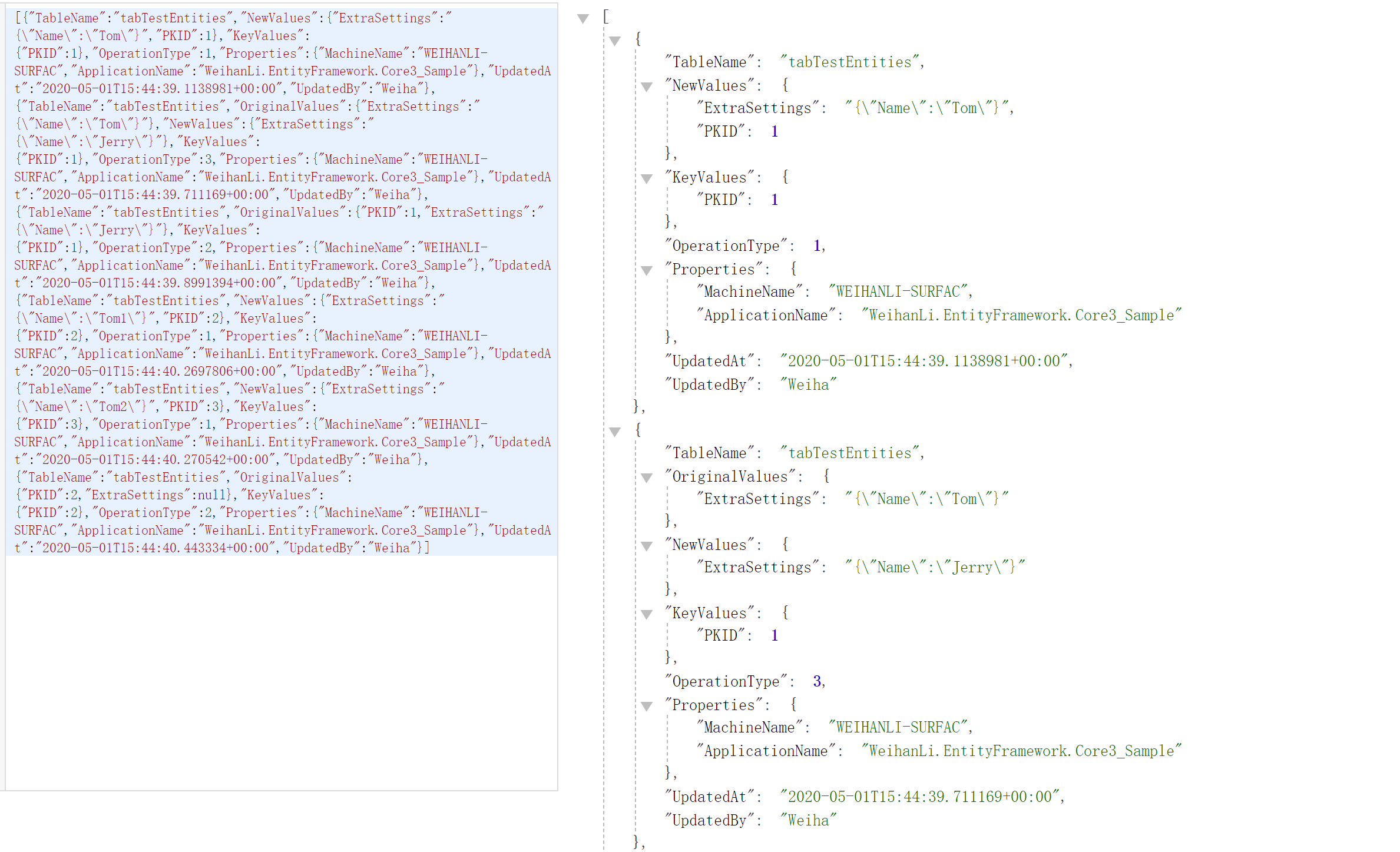打造更好用的 EF 自动审计
结合 AOP 打造更好用的 EF 自动审计
打造更好用的 EF 自动审计
Intro
上次基于 EF Core 实现了一个自动审计的功能,详细可以参考 https://www.cnblogs.com/weihanli/p/auto-audit-for-entity-framework.html ,虽然说多数情况下可以适用,但是因为要显式继承于一个 AuditDbContextBase 或 AuditDbContext,所以对代码的侵入性比较强,对于已经无法修改的代码或者已经继承于某一个类了,就无法再继承 AuditDBContext 了,就没有办法实现自动审计了,在 WeihanLi.EntityFramework 1.7.0 新版本里引入了 AOP 的设计,结合 AOP 来实现就简单很多了,不再需要对原有的 DbContext 有任何修改就可以轻松实现自动审计了,下面来看如何做
实例演示
服务注册
使用 AddProxyDbContext 代替 AddDbContext,AddProxyDbContextPool 代替 AddDbContextPool,会自动注册代理服务,以实现 AOP 拦截
var services = new ServiceCollection();// 使用内置的扩展注册 DbContext 代理服务//services.AddProxyDbContext<TestDbContext>(options =>//{// options// .UseLoggerFactory(loggerFactory)// //.EnableDetailedErrors()// //.EnableSensitiveDataLogging()// // .UseInMemoryDatabase("Tests")// .UseSqlServer(DbConnectionString)// //.AddInterceptors(new QueryWithNoLockDbCommandInterceptor())// ;//});// 使用内置的扩展注册 DbContextPool 代理服务,只是为了方便使用,只会代理 DbContextservices.AddProxyDbContextPool<TestDbContext>(options =>{ options .UseLoggerFactory(loggerFactory) //.EnableDetailedErrors() //.EnableSensitiveDataLogging() // .UseInMemoryDatabase("Tests") .UseSqlServer(DbConnectionString) //.AddInterceptors(new QueryWithNoLockDbCommandInterceptor()) ;});// 注册 AOP 服务services.AddFluentAspects(options =>{ // 配置使用 AuditDbContextInterceptor 拦截 DbContext 的 SaveChanges 和 SaveChangesAsync 方法 options.InterceptMethod<DbContext>(m => m.Name == nameof(DbContext.SaveChanges) || m.Name == nameof(DbContext.SaveChangesAsync)) .With<AuditDbContextInterceptor>() ;});// 注册 serviceLocator(可选,根据自己需要DependencyResolver.SetDependencyResolver(services);审计配置
AuditConfig.Configure(builder =>{ builder // 配置操作用户获取方式 .WithUserIdProvider(EnvironmentAuditUserIdProvider.Instance.Value) //.WithUnModifiedProperty() // 保存未修改的属性,默认只保存发生修改的属性 // 保存更多属性 .EnrichWithProperty("MachineName", Environment.MachineName) .EnrichWithProperty(nameof(ApplicationHelper.ApplicationName), ApplicationHelper.ApplicationName) // 保存到自定义的存储 .WithStore<AuditFileStore>() .WithStore<AuditFileStore>("logs0.log") // 忽略指定实体 .IgnoreEntity<AuditRecord>() // 忽略指定实体的某个属性 .IgnoreProperty<TestEntity>(t => t.CreatedAt) // 忽略所有属性名称为 CreatedAt 的属性 .IgnoreProperty("CreatedAt") ;});使用示例
DependencyResolver.TryInvokeService<TestDbContext>(dbContext =>{ dbContext.Database.EnsureDeleted(); dbContext.Database.EnsureCreated(); var testEntity = new TestEntity() { Extra = new { Name = "Tom" }.ToJson(), CreatedAt = DateTimeOffset.UtcNow, }; dbContext.TestEntities.Add(testEntity); dbContext.SaveChanges(); testEntity.CreatedAt = DateTimeOffset.Now; testEntity.Extra = new { Name = "Jerry" }.ToJson(); dbContext.SaveChanges(); dbContext.Remove(testEntity); dbContext.SaveChanges(); var testEntity1 = new TestEntity() { Extra = new { Name = "Tom1" }.ToJson(), CreatedAt = DateTimeOffset.UtcNow, }; dbContext.TestEntities.Add(testEntity1); var testEntity2 = new TestEntity() { Extra = new { Name = "Tom2" }.ToJson(), CreatedAt = DateTimeOffset.UtcNow, }; dbContext.TestEntities.Add(testEntity2); dbContext.SaveChanges();});DependencyResolver.TryInvokeService<TestDbContext>(dbContext =>{ dbContext.Remove(new TestEntity() { Id = 2 }); dbContext.SaveChanges();});// disable auditAuditConfig.DisableAudit();// enable audit// AuditConfig.EnableAudit();审计日志输出结果


More
这样以来就不需要修改原有代码了~~,心情大好,哈哈~
如果应用多有多个 DbContext 有的需要审计,有的不需要审计,则可以在配置的时候指定具体的 DbContext类型如 TestDbContext,这样就只会启用 TestDbContext 的自动审计,别的 DbContext 比如 Test2DbContext 就不会自动审计了
Reference
- https://github.com/WeihanLi/WeihanLi.EntityFramework/blob/dev/samples/WeihanLi.EntityFramework.Core3_0Sample/Program.cs
- https://www.nuget.org/packages/WeihanLi.EntityFramework/
- https://www.cnblogs.com/weihanli/p/auto-audit-for-entity-framework.html
没有评论:
发表评论